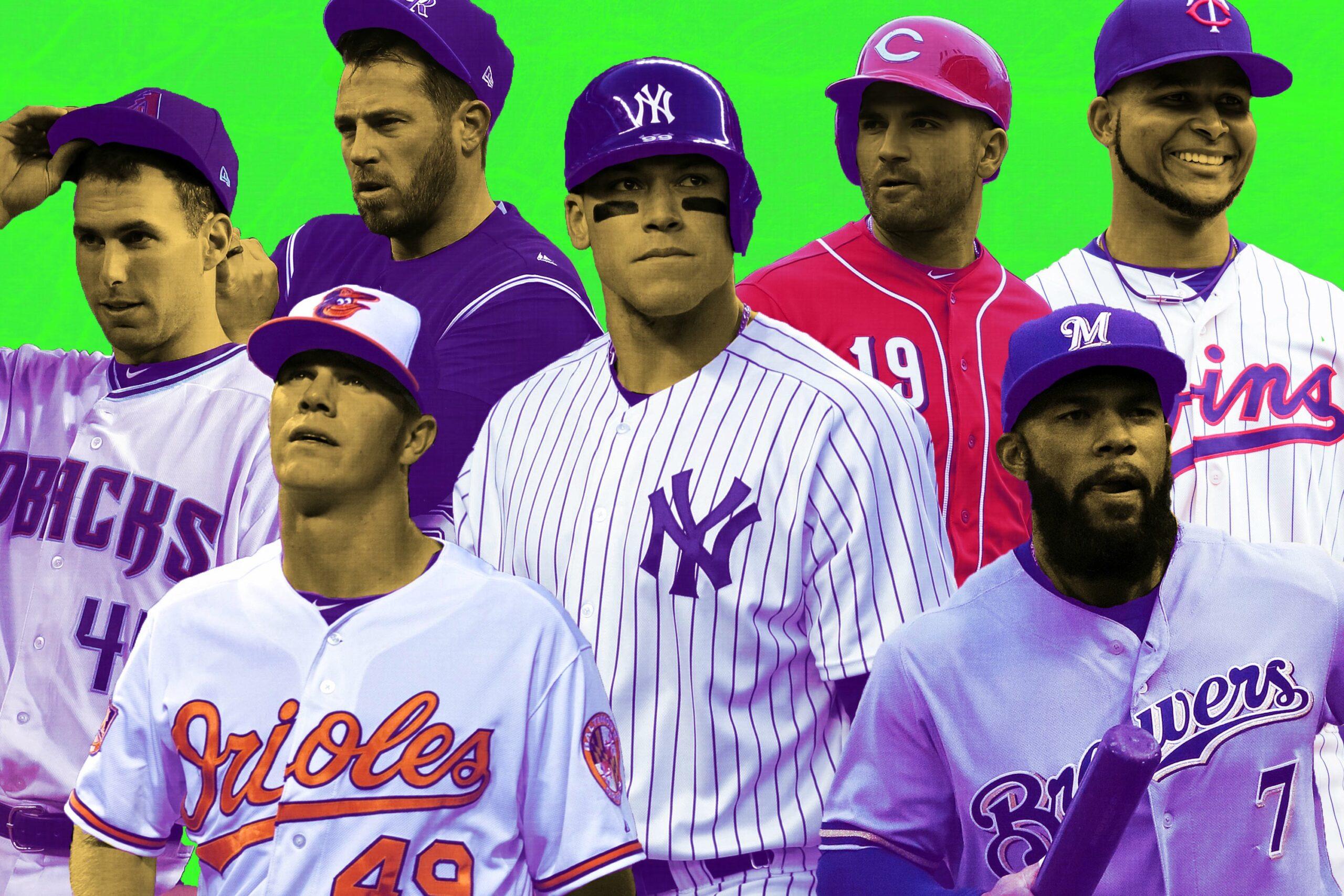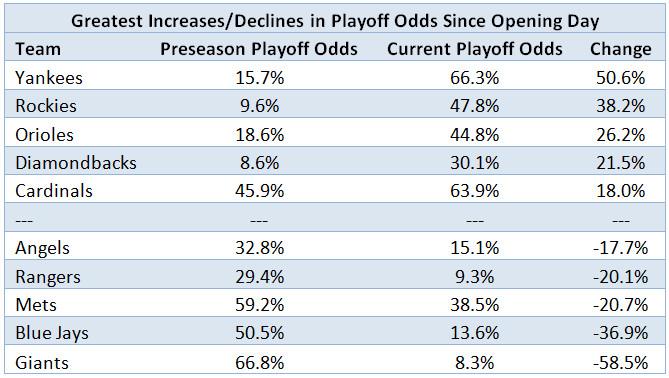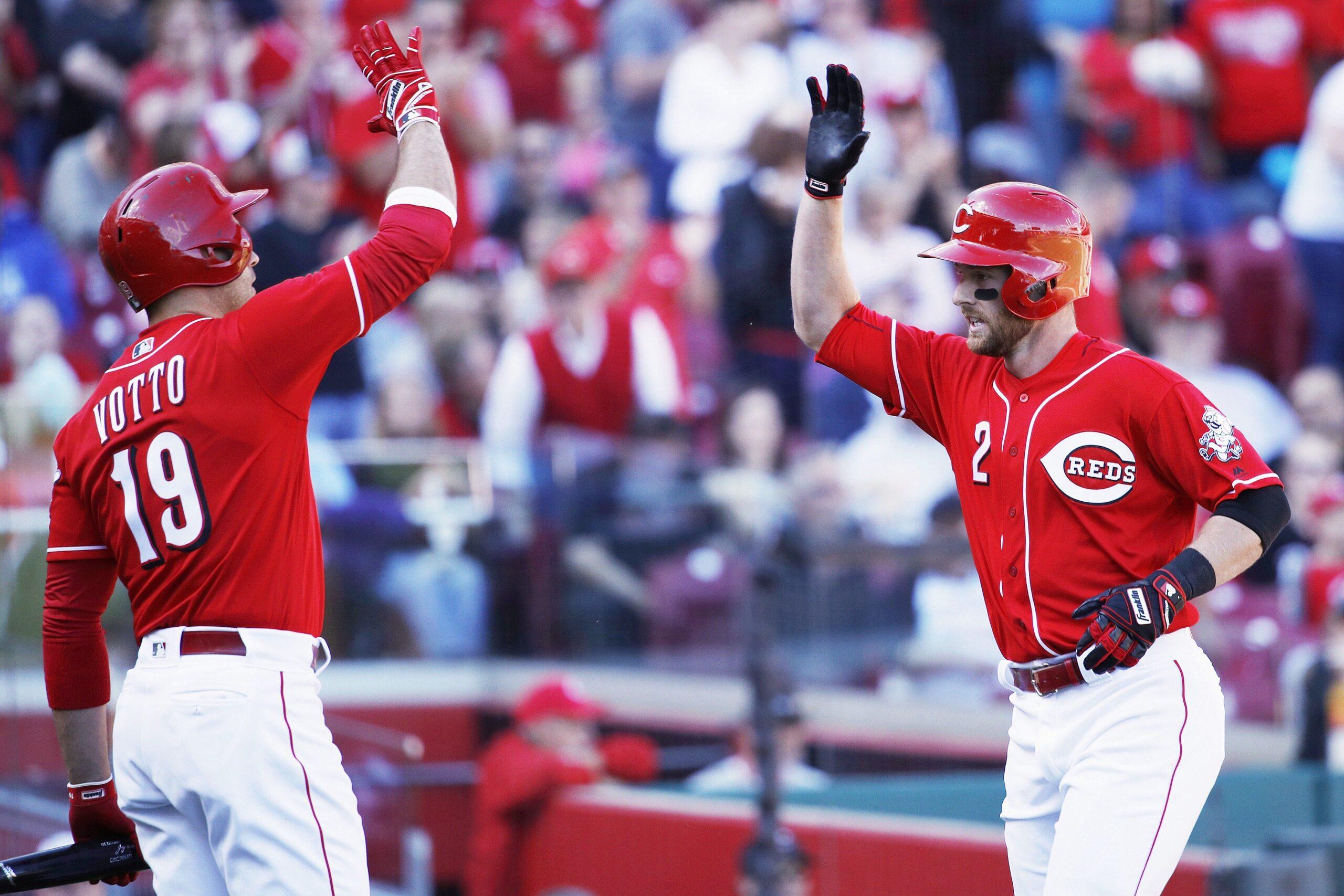
On Opening Day, FanGraphs unsurprisingly projected half of MLB’s teams to lose more games than they’d win. Of those 15 likely losers, seven have so far won more games than they’ve lost. Right now, someone who saw that last sentence is saying, "That’s why they play the games!" Yes, someone, you’re right.
But I’m not here to trash the projections. Because "they" have so many more games to play, the projections will probably be right in the long run — or, at least, more right than the records today. Even in mid-June, preseason projections are a better guide to the typical team’s rest-of-season performance than performance up to that point, as measured by either actual or Pythagorean record. And we’re still a month from mid-June.
If these seven teams had gotten out of the gate slowly but managed respectable spans of 30-ish games at midseason, we might not even notice, but we’re all suckers for stories that are fun from the start. Some of those stories will be spoiled soon: FanGraphs’ updated projections, which account for 2017 stats as well as changes to expected playing time, say that only four of the seven unexpected early-season winners will still have winning records by the end of the year, with just one of them expected to play .500 or better from this point forward. But before some of these clubs’ seasons head south, let’s examine how each of the seven (in order of current 2017 winning percentage) has surpassed expectations to date while weighing the likelihood that its good times can continue.
New York Yankees (Actual: .677; Expected: .488)
The Yankees, who’ve improved their playoff odds more than any other club, have played like the best team in baseball, scoring the second-most runs in the majors while allowing the third fewest. They’ve outslugged other teams despite the almost-month-long absence of Gary Sánchez, a 6-for-60 start by Greg Bird and, briefly, the presence of Pete Kozma, and they’ve managed great run prevention despite a combined ERA above 5.00 from Masahiro Tanaka and CC Sabathia.

Aaron Judge’s breakout has been a big part of that, but the Yankees have also benefited from a confluence of other surprisingly sudden steps forward, as well as several veterans’ refusal to take steps back. Aaron Hicks, who’s four years removed from his most recent preseason prospect ranking, has enjoyed his own Judge-like offensive surge. Starlin Castro is riding a BABIP bounce, while Brett Gardner, Jacoby Ellsbury, and Chase Headley have all rebounded from lousy 2016s. At 37, Matt Holliday has been his old self in every sense. And the tantalizing Michael Pineda and Luis Severino have two of the top five K-BB percentages among qualified starters, keeping company with Chris Sale, Max Scherzer, and Clayton Kershaw.
On top of that, there’s the bullpen. With Aroldis Chapman and Dellin Betances at the back, it was bound to be good, but Tyler Clippard, Adam Warren, and Jonathan Holder have given the Yankees a deep collection of strikeout-inducers. Great late-inning relievers have helped the Yankees extend their apparently endless winning-season streak despite being outscored in three of the past four seasons, and their latest good bullpen is backed up by the bones of a budding best team in the East. The Yankees aren’t that good yet, but the latest playoff odds accord them a better chance of winning a wild card than any other AL team.
Baltimore Orioles (Actual: .667; Expected: .492)
If I were here to trash the projections, Baltimore would be the best place to start. No other team has made the stats seem as silly over the past several years, and the Orioles have been at it again. Here’s my favorite stat about the 2017 Orioles’ defiance of projections: On Opening Day, the projections forecasted a .492 winning percentage for Buck Showalter’s team. After the O’s started the season 22–10, the projections revised their estimate of the Orioles’ rest-of-season performance to … .485. The Orioles posted the best record in baseball over the first five-plus weeks of the season, and the projections’ appraisal of their future performance got worse.
Now, that could be because expectations for O’s opponents improved (particularly the Yankees, the first team on our list). It could be because closer Zach Britton is hurt. But it’s also because the Orioles haven’t played especially well in the ways that sway projection systems. During their 22–10 start, the Orioles’ BaseRuns record — which translates teams’ underlying offensive and defensive performance, independent of sequencing, into expected wins and losses — was only 16–16. The Orioles beat their BaseRuns record by six wins over a span during which no other team over- or underperformed its BaseRuns record by more than three wins.
On offense, Orioles non-pitchers rank 20th in the majors in park-adjusted production per plate appearance. On defense, the Orioles have been below average by both defensive runs saved and ultimate zone rating. Their starting pitchers have baseball’s seventh-worst FIP. Even their bullpen’s raw stats seem middling. But only four teams’ pens have a higher win probability added. As usual — and even without Britton — the Orioles bullpen is bailing them out by being better when it matters most. (It was, anyway, until Brad Brach blew a save in spectacular fashion on Wednesday, after Showalter intentionally walked the winning run on base.)
Most teams have taught us that this isn’t a way to keep winning. The Orioles keep trying to teach us that with the right relievers and manager, it is.
Colorado Rockies (Actual: .629; Expected: .480)
The Rockies were such a popular "surprise" pick this spring that their ensuing success isn’t so surprising, although a raft of injuries in the middle of March persuaded me not to add my own pro-Rockies piece to the pile. In retrospect, I probably should have. These Rockies haven’t followed the "outhit everyone" strategy for Coors Field contention; in raw runs scored, their Mark Reynolds–led(!) lineup, dragged down by Carlos González’s abysmal start, is tied for ninth in baseball, and after adjusting for park, it falls to 27th. Instead, they’ve excelled on the mound, recording what would be the best park-adjusted ERA in franchise history.
For all the years that we’ve heard about the wisdom of keeping balls out of Denver’s thin air, no Rockies staff has ever gotten ground balls with the regularity of this one, which leads MLB with a 52.1 percent grounder rate. Rockies pitchers are also leading the majors in four-seam-fastball rate, which seems wise in light of the harmful effects the altitude Coors is at can have on pitch movement. Even without Chad Bettis, and with Jon Gray missing most of the past month, the Rockies’ 27-and-under starting staff — whose youngest member, German Márquez, no-hit the Cubs for six innings on Wednesday — has held up. The bullpen, led by a trio of Tommy John surgery survivors (Greg Holland, Adam Ottavino, and Jake McGee) has led the majors in win probability added, more than doubling Baltimore’s total.
The Rockies have also been better when balls are put in play, ranking fourth in the majors in defensive runs saved and appearing on track for their first positive UZR total since the pennant-winning 2007 team. The Rockies have outscored their opponents by only nine runs, but by virtue of their banked wins, they have baseball’s best odds of winning a wild card.
Cincinnati Reds (Actual: .545; Expected: .417)

The presence of Eugenio Suárez and Zack Cozart in 10th and 14th places, respectively, on the FanGraphs WAR leaderboard is a useful reminder that the season is still young. Along with Joey Votto, that less-heralded duo has given Cincinnati three position players in the top 25. Only the Nationals and the Yankees have gotten a greater contribution from their position players than the Reds, who lead the majors in defensive runs saved. Last year, the Reds defense rated tied for sixth worst, but José Peraza and Scott Schebler have been big upgrades in the field over Brandon Phillips and Jay Bruce, respectively.
As one would expect, the team’s Scott Feldman–fronted rotation, which gets only more Bronson Arroyo–filled from there, has recorded the second-worst park-adjusted ERA in the majors, but Bryan Price has compensated by deploying his nontraditional bullpen for more innings than any other team’s. At least the staff as a whole has cleared replacement level, which represents an improvement compared with last year’s. There’s no real reason to think the Reds can sustain this success, but they’ve probably done enough already to save themselves from the horrible fate that was supposed to be in store. The Padres were the only team with a worse expected winning percentage when the season started, and they’re 13–21.
Arizona Diamondbacks (Actual: .543; Expected: .477)
As expected, Arizona’s rotation has been the strongest part of the roster, leading the majors in starting-pitcher WAR behind a resurgent Zack Greinke. The bullpen, which was projected to be the big leagues’ worst, has yielded MLB’s ninth-best park-adjusted FIP, thanks to former top prospect Archie Bradley’s conversion into a multi-inning relief weapon, Andrew Chafin’s improved control, and solid work from post–New Year’s free-agent signees Jorge De La Rosa and J.J. Hoover. And while the lineup has lacked a standout aside from the never-not-mashing Paul Goldschmidt, it’s also lacked a below-average line from any starter not named Jeff Mathis (who along with Chris Iannetta has improved the Diamondbacks’ framing from fifth worst to eighth best).
A great rotation and average-ish everything else — MLB-low defensive runs saved total aside — should be capable of producing the Diamondbacks’ first winning season since 2011, although the rotation isn’t as deep as it once was. Zach Godley isn’t bad by fifth-starter standards, but the loss of a seemingly fixed Shelby Miller to Tommy John surgery weakens the one area in which the D-backs could have matched most contending teams.
Minnesota Twins (Actual: .533; Expected: .462)
Last year, the Twins pitching staff ranked second worst in WAR, and the team finished with the fewest wins in the majors. This year, the Twins pitching staff ranks worst in WAR, and the team has a winning record. The Twins still don’t strike out opposing hitters, but they no longer pair their contact-prone pitchers with awful fielders. The Twins rank second to Cincinnati in defensive runs saved, which constitutes an even greater turnaround than the Reds’, relative to 2016; last year’s unit ranked third-to-last.
With Miguel Sanó and Robbie Grossman stationed at third base and DH, respectively, and Byron Buxton — who’s no longer looking as lost at the plate as he was for much of April — manning center, Minnesota’s outfield can cover much more ground than it could last season. Jorge Polanco has been a big upgrade over Eduardo Escobar at short. And thanks to the offseason signing of catcher Jason Castro, the Twins are above average in framing runs, after being by far the worst team at stealing strikes over the previous five years (and sixth worst last season).
This isn’t a good team: The offense has been the Sanó show, and the pitching just isn’t there. (I’m shorting Ervin Santana’s stock.) But as sabermetrician Phil Birnbaum once wrote, "You gain more by not being stupid than you do by being smart." The Twins stopped being stupid when they stopped pitching to contact that their fielders were ill-equipped to corral.
Milwaukee Brewers (Actual: .529; Expected: .435)
The Brewers owe much of their positive run differential to Eric Thames: They’ve outscored their opponents by 12 runs, and Thames has been worth almost 20. Take Thames away, and the highlight here is an outfield trio of Ryan Braun, Domingo Santana, and Keon Broxton, who like Buxton looked lost early on but has since started to justify the preseason internet love. The Brewers’ record has been propped up by their pitching staff’s MLB-best cluster luck, which isn’t likely to last.
Things are going to get worse, and the decline could be compounded if GM David Stearns stays active in the trade market and deals Braun and anyone else who’s not nailed down — even Thames, potentially, if the temptation to convert the 30-year-old’s significant surplus value to prospects becomes irresistible. Still, this should be the point in the team’s rebuild when the Brewers are bottoming out, and they’re nowhere near the depths of the 2012 Cubs or 2013 Astros. So far, Stearns has stocked his team with enough decent depth to field a credible big league roster while still constructing a strong farm system.

